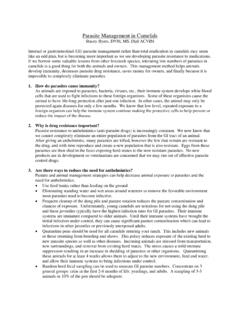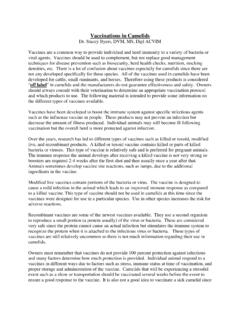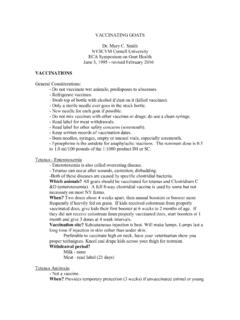Transcription of Caseous Lymphadenitis in Small Ruminants
1 Caseous Lymphadenitis in Small Ruminants Dave Van Metre, DVM, DACVIM Professor / Extension Veterinarian Colorado State University Caseous Lymphadenitis is a contagious bacterial infection of the lymph nodes of sheep and goats. It is caused by a bacterium called Corynebacterium pseudotuberculosis. This bacterium is extraordinarily durable, apparently able to survive in soil for months to years, even in dry climates with substantial sun exposure. It is commonly found in the soil on farms with infected animals. It causes the development of abscesses within the lymph nodes of infected sheep and goats.
2 Abscesses can form as soon as 2 weeks after exposure to the organism, although it can take several months for abscesses to develop in some cases. Infection occurs through contact with pus containing the organism, which commonly occurs when an infected animal develops a draining wound emanating from an infected lymph node. The draining material may be directly transferred to another animal through contact, or it may contaminate the soil, bedding, water, or feed and be transferred through these routes. In dairy sheep and goats, contaminated milking machines can spread the organism.
3 The organism can also be spread by shearing equipment, combs, or other tack that is contaminated with pus. Flies may spread the organism from one animal to another by feeding on infected material and moving to another animal to feed on a wound. There are two forms of the disease. In the external form, the lymph nodes immediately under the skin become infected and visibly enlarged, growing to a size of 1-2 inches to several inches in diameter. The lymph nodes that are most commonly involved are located at the angle of the jaw, in front of the shoulder, and in the lower flank.
4 Occasionally, the lymph nodes located within the udder become infected, creating lumps that may become large enough to see. With time, the skin above the infected lymph node will become thin and weak, and the infected lymph node may rupture through the weakened skin, releasing thick, greenish-white pus. The draining wound eventually heals over, but in the process, the environment becomes heavily contaminated with the causative bacterium contained in the pus. The external form of Caseous Lymphadenitis is a common cause for rejection of animals at registration for sales and fairs.
5 In the internal form of Caseous Lymphadenitis , the lymph nodes deep within the body become infected. These lymph nodes can be located anywhere in the body, although the lymph nodes located within the chest cavity are most commonly involved. The lymph nodes enlarge and may impinge upon surrounding organs; however, the most common sign of the internal form of this disease is weight loss in adults or slow to minimal weight gain in younger animals. Affected animals may succumb to weakness from progressive weight loss or may suffer complications related to impingement of the enlarged lymph nodes on other organs.
6 At slaughter, the internal form of Caseous Lymphadenitis is a very common cause of carcass condemnation in sheep and goats of all ages. Treatment of the external form involves identification of affected animals prior to abscess rupture and isolation of these animals well away from the main herd or flock. Treatment may involve culling of affected animals if the disease is rare in the flock or herd. Alternatively, your veterinarian may decide to isolate the affected animal, lance the abscess, flush the abscess cavity with an antiseptic solution, and pack the cavity with gauze or other bandage material to minimize contamination of the farm environment with the infected material.
7 Any material that is drained from infected lymph nodes should be carefully collected and disposed of as biologic waste, rather than allowed to drain into bedding or soil. Surgical removal of infected lymph nodes is another treatment option. Recently, injection of a particular antibiotic directly into the infected lymph node has shown promise as a treatment. Consult your veterinarian to determine the most appropriate course of treatment for each case. Spontaneous rupture and healing of abscesses can occur; however, this practice will result in heavy contamination of the environment with Corynebacterium pseudotuberculosis and is not recommended.
8 Treatment of the internal form of Caseous Lymphadenitis requires long-term antibiotic treatment. Achieving a complete cure can be very difficult. Prevention of Caseous Lymphadenitis Don t buy it in screen newly purchased animals for signs of lymph node enlargement and decline to purchase affected animals. Practice aggressive fly control. Disinfect shearing equipment, combs and other tack, and milking equipment between animals. Vaccination against Caseous Lymphadenitis may reduce the number of animals that become infected on a given farm, as well as reduce the number of abscesses that develop in affected animals; however, vaccination will not eliminate the disease entirely.
9 Animals with abscesses that are about to rupture should be well isolated from the remainder of the population until the infection is resolved. Your veterinarian can determine if the lymph node abscess can be safely lanced and drained. Horses develop an infection with a different strain of the same bacterium; this disease is commonly called pigeon fever in horses. However, horses do not appear to be capable of transmitting infection to Small Ruminants (sheep and goats), and Small Ruminants do not appear to be capable of transmitting infection to horses.
10















